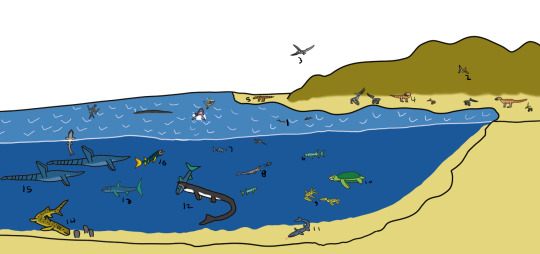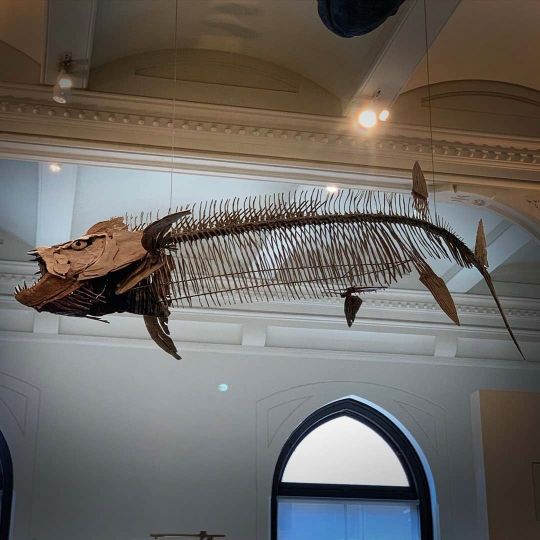#Xiphactinus audax
Explore tagged Tumblr posts
Text

Reconstruction of Xiphactinus audax from 2021. Yes, that was the time when I drew a fish. This large (up to 5-6 meters) actinopterygian fish was previously known as Porteus molossus. Its characteristic feature is the forward-thrust lower jaw, which gives a resemblance to a bulldog. Several Xiphactinus specimens have been preserved with the ingested prey inside (in one case 4,2 m. individual swallowed 1,9 m. Gillicus). They could have died because of the resistance of the victims, which led to ruptures of internal organs. Done with ballpoint pen, colored pencils and watercolors.
#xiphactinus audax#xiphactinus#gillicus#ichthyodectidae#actinopterygii#late cre#late cretaceous#paleoart
11 notes
·
View notes
Note

Bonus: semi-full-frontal Xiphactinus audax skeleton from the American Museum of Natural History in New York City (took this last weekend)
We'll call it close enough because I fucking love skeletons
34 notes
·
View notes
Text

A fossilized fish tooth of a Xiphactinus vetus or X-fish from the Blufftown Formation in Barbour County, Alabama, United States. The species of X-fish was originally misidentified as a mosasaur under the species, Polygonodon vetus. Xiphactinus vetus can be distinguished from Xiphactinus audax from the prominent carinae and cross-section shape.
#fish#fossils#paleontology#palaeontology#paleo#palaeo#xiphactinus#polygonodon#x-fish#ichthyodectidae#cretaceous#mesozoic#prehistoric#science#paleoblr#シファクティヌス#クシファクティヌス#イクチオデクテス科#化石#古生物学
13 notes
·
View notes
Text










Life of our Prehistoric Planet: X-fish (Xiphactinus audax).
#prehistoric planet#prehistoric planet 2#xiphactinus#fish#x-fish#the muskrat would cream his pants over this thing's name#q
2 notes
·
View notes
Photo

A Day in Niobrara
1. Hesperornis regalis 2. Nyctosaurus gracilis 3. Pteranodon longiceps 4. Claosaurus agilis 5. Niobrarasaurus coleii 6. Gillicus arcuantus 7. Enchodus petrosus 8. Platecarpus tympaniticus 9. Dolichorhynchops osborni 10. Protostega gigas 11. Clidastes prophython 12. Tylosaurus proriger 13. Bonnerichthys gladius 14. Ptychodus mortoni 15. Styxosaurus snowii 16. Xiphactinus audax 17. Cretoxyrhina mantelli
#niobrara#hesperornis#nyctosaurus#pteranodon#claosaurus#niobrarasaurus#gillicus#enchodus#platecarpus#dolichorhynchops#protostega#clidastes#tylosaurus#bonnerichthys#ptychodus#styxosaurus#xiphactinus#cretoxyrhina
3 notes
·
View notes
Video
Xiphactinus audax
by Gerardo Rico
82 notes
·
View notes
Photo


Xiphactinus Audax McWane Science Center Birmingham, Alabama March 27, 2022
#alabama#birmingham alabama#mcwane science center#science center#science museum#museums#dinosaurs#fossils#giant fish#sea creatures#xiphactinus audax#prehistoric#our adventures
4 notes
·
View notes
Text





Some statistics sketches, postcards and memories of the Niobrara.
#from davey jones locker#scienceblr#paleoblr#paleontology#pencil sketch#ink sketch#sketchbook#sketch#class doodles#cretaceous#niobrara sea#western interior seaway#tylosaurus proriger#xiphactinus audax#dolichorhynchops#dolichorynchops osborni#megacephalosaurus eulerti#protosphyraena pernicosa#pliosaur#mosasaur#paleoart#paleoartist#prehistoric#mesozoic
10 notes
·
View notes
Text
Day 23: ancient - my namesake, xiphactinus audax

#inktober2019#inktober#fish#xiphactinus#xiphactinus audax#prehistoric#prehistoric fish#cretaceous#fossil#extinct animals#xiphactinusfish
7 notes
·
View notes
Photo



Gigantic Fossil Fish Skull, (Xiphactinus audax, Cretaceous) - Niobrara Formation, Smoky Hill Chalk, Gove County, Kansas
There are a total of 25 real teeth of various sizes; the largest tooth is 2” (5 cm.) long. There are two Squalicorax (shark) teeth in the posterior area of the skull, plus the trauma to this area, indicates that sharks and other scavengers most likely ate the body of this fish. This is one of the largest bony fish species (except sharks) that ever roamed the Cretaceous seaway. The estimated entire length of the fish would have been about 14 feet (4.27 m) long and it would have weighed about 85 pounds (38.56 kg).
1K notes
·
View notes
Photo

🐟Here's a ferocious fossil fish for #FossilFriday: Xiphactinus audax. It lived during the Late Cretaceous some 85 million years ago. Xiphactinus and its relatives were large predators with strong jaws and many teeth. 🌊It swam in the great inland sea that covered most of North America at the end of the Age of Dinosaurs. Pictured is a skeleton cast that’s suspended from the ceiling of the Museum’s Hall of Vertebrate Origins—and a fossil specimen of this fish is on display in a case beneath it. The Museum is open daily from 10 am–5:30 pm. Plan your trip! Photo: E. Louis/© AMNH #AnimalFacts #fish #dyk #fossils #AncientAnimals #Cretaceous #amnh #museums #AncientOcean (at American Museum of Natural History) https://www.instagram.com/p/CiAWWpJgu-Q/?igshid=NGJjMDIxMWI=
288 notes
·
View notes
Text
Dibujo de Xiphactinus 🐟
Un enorme pez óseo depredador, y uno muy conocido, vivió en de período cretácico.
Era mesozoica.
género: xiphactinus Especie: xiphactinus Audax.
Año de descubrimiento de la especie:1870

#animals#digital art#art#digital illustration#fish#paleoart#prehistoric animals#marine animals#sealife#mesozoica#xiphactinus
13 notes
·
View notes
Note
you got anything about dinosaur fish?
so i'm lucky in that my 'local' museum is the smithsonian (enormous! free!), but unlucky in that 1. i haven't been there in well over a year now 2. the fossil hall in the NHM had been under renovation for like five years and i ... don't like the new one. in many ways it is absolutely better and far more up-to-date than the old one, but ... in some ways it feels weirdly sterile, which i think is the obvious opposite of what a natural history museum should be.
on the other hand it does have a bigass fish with another bigass fish inside of it.

(by Beth Py-Lieberman for Smithsonian Magazine)
this is Xiphactinus audax, and I think it says something that I know of at least one other living thing with the specific name audax and it is also known for eating shit that seems waaaay too big for it to eat. there are at least a dozen Xiphactinus specimens with other fish inside them, one that died trying to eat a mosasaur, and one 13-foot Xiphactinus that ate a 6-foot fish and then died, probably because the prey fish burst its organs, because don't eat things literally half your size. also it had this incredible goofy pug face that i love.

(Art by Johnson Mortimer)
on the other hand, it lived in the Western Interior Seaway, which used to split Cretaceous North America up into two separate continents from north to south, and which was filled with what was arguably too many giant animals, seemingly mostly predators. tiger-shark-like Squalicorax! great-white-like Cretoxyrhina! Ptychodus, a 30-foot-long mollusk-eating shark! Hesperornis, a six-foot toothy pseudopenguin thing! Elasmosaurus, which was 2/3 neck! Tylosaurus, a genus of mosasaur whose members could be up to 50 feet long! also VERY big turtles
my other favorite prehistoric fish is Leedsichthys, because Big.

(art by Eotyrannu5)
also because its specific name is fucking. problematicus
39 notes
·
View notes
Photo



The Final Meal
One of the most famous fish fossils in the world, the Fish-Within-A-Fish displays the body of a Xiphactinus audax with a Gillicus arcuatus between the ribs - swallowed whole.
101 notes
·
View notes
Photo

Xiphactinus audax was a carnivorous fish that swam the oceans during the Late Cretaceous Period, between 112 and 66 million years ago. It could grow up to nearly seventeen feet in length, so you wouldn’t want to bump into it if you were swimming in the Cretaceous seas (that is, if one of the myriad other big and fierce monsters lurking in there didn’t get you first).
The bioluminescent spots I have given this specimen are a speculative addition on my part.
3 notes
·
View notes
Text
Styxosaurus snowii, S. browni

Art by: Andrey Belov, https://www.deviantart.com/abelov2014/art/Styxosaurus-Xiphactinus-audax-var-1-658020267
Name: Styxosaurus snowii, S. browni
Name Meaning: Styx lizard (River Styx in Greek mythology)
First Described: 1943
Described By: Welles
Classification: Chordata, Tetrapoda, Reptilia, Sauropterygia, Plesiosauria, Elasmosauridae
Styxosaurus was an elasmosaurid plesiosaur that existed during the Late Cretaceous. It was a big one, estimated to have been between 36-39 feet (11-12 meters) in length. The neck of Styxosaurus took up half of its total body length, remember, very long necks were typical features seen in elasmosaurs. Their teeth were a part of the pierce guild, so their teeth were pointy and made to hook in fish, squid, and other slippery prey items. One Styxosaurus specimen had 250 gastroliths found within its stomach contents along with bones of fish. These gastroliths are currently hypothesized to have been digestive aids to allow for fish, squid, and more consumed victims to be grinded for better digestion.
Sources:
http://www.prehistoric-wildlife.com/species/s/styxosaurus.html
https://en.wikipedia.org/wiki/Styxosaurus
#Styxosaurus#palaeoblr#paleontology#palaeontology#prehistoric#Mesozoic#ancient marine reptiles#Not a dinosaur#sauropterygia
34 notes
·
View notes